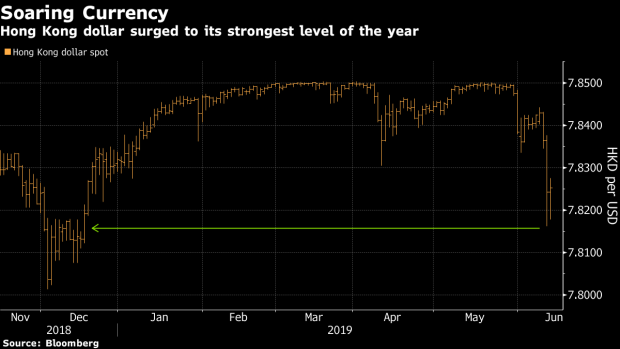Jun 13, 2019
Hong Kong's Liquidity Is Very Tight. Here's What That Looks Like
, Bloomberg News

(Bloomberg) -- Street protests, a sliding stock market and a surging currency. There’s a lot going on in Hong Kong.
On top of that, tighter liquidity has sent interbank borrowing costs soaring. This is partly the result of seasonal factors: demand for cash usually increases in June as banks hoard funds for regulatory checks and companies pay dividends. The planned listing of Alibaba Group Holding Ltd. also is a reason, as investors set aside money to get a piece of the Chinese giant’s debut in the city.
Higher borrowing costs have roiled markets already wobbling as relations between the world’s two largest economies frayed. A gauge of Hong Kong developers fell the most in five months on Wednesday, while the local currency is near its strongest level of the year -- and should see more gains, said Irene Cheung, senior strategist at Australia & New Zealand Banking Group Ltd.
“The Hong Kong dollar will continue to advance, as traders have closed their short positions on spiking interbank rates,” Cheung said. “The local political situation and uncertainty over the escalating China-U.S. trade tensions may have triggered outflow concerns, which could also lead to tighter liquidity.”
The currency may rise beyond HK$7.82 to the greenback in the next two weeks, she said. The Hong Kong dollar was trading at HK$7.8258 on Thursday evening.
These five charts help illustrate how tight liquidity in Hong Kong is:
The Hong Kong dollar jumped the most since November on Wednesday as borrowing costs spiked. The currency traded near the weak end of its trading band at HK$7.85 for much of the year, compelling the city’s monetary authority to spend HK$22.1 billion ($2.8 billion) defending it in March.
The Hong Kong dollar one-month interbank rate has jumped 49 basis points in the past two days, pushing it to the highest in more than a decade and above the level of its U.S. counterpart as of Tuesday. When the gap between the Hibor and Libor was wide, it was attractive for investors to sell Hong Kong dollars to buy U.S. assets -- a phenomenon that weakened the currency.
The Hong Kong dollar’s one-year interest rate swaps have climbed to as high as 2.22%, expanding the premium against five-year contracts to the largest since January 1999. While seasonal factors and big IPOs may keep short-tenor contracts elevated, global easing and few worries about outflows given Hong Kong’s large reserves have kept long-end swaps from rising, according to OCBC Wing Hang Bank Ltd. economist Carie Li.
The cash squeeze has pushed the Hong Kong dollar’s one-month interbank borrowing cost above the 12-month tenor for the first time in more than a decade. The tightening caused by lenders’ hoarding of funds is also magnified by a dwindling liquidity pool -- the aggregate balance has halved over the past year as local authorities defended the city’s currency.
The tightness isn’t limited to the interbank market. The Hong Kong dollar’s 12-month forward points, a gauge of borrowing costs in the foreign-exchange market, are the highest since January 2017. This also means that shorting the currency has become a lot more expensive, supporting the local dollar.
--With assistance from Martin Ritchie.
To contact the reporters on this story: Tian Chen in Hong Kong at tchen259@bloomberg.net;Claire Che in Beijing at yche16@bloomberg.net
To contact the editors responsible for this story: Sofia Horta e Costa at shortaecosta@bloomberg.net, Philip Glamann, Will Davies
©2019 Bloomberg L.P.